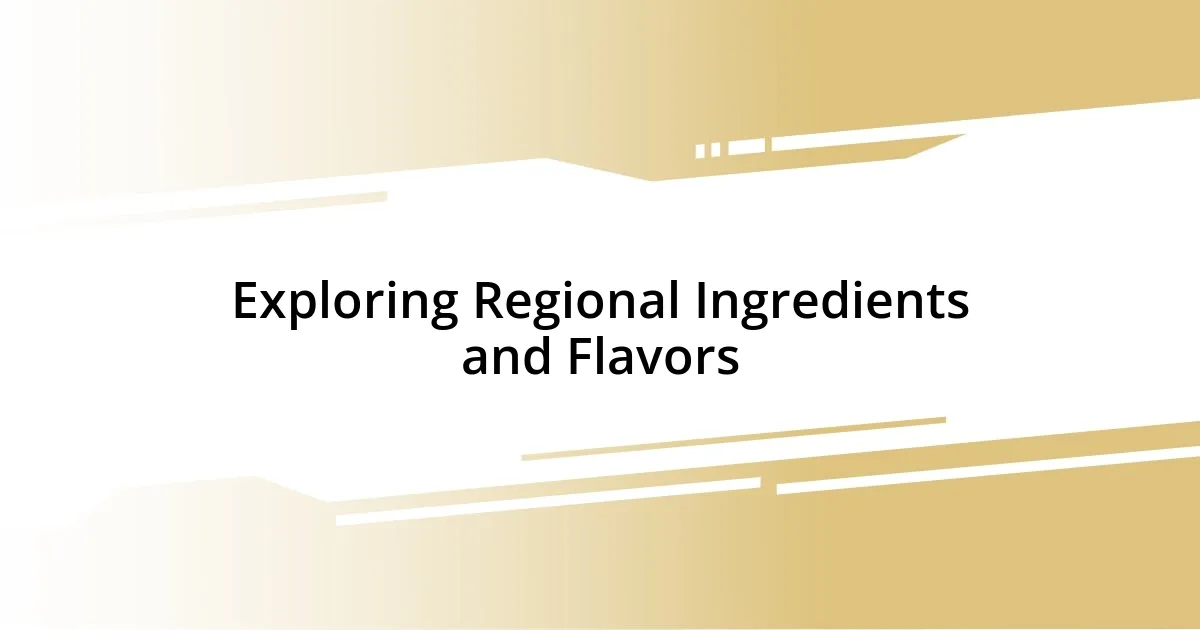Key takeaways:
- Local cooking traditions embody cultural identity, reflecting history and community through the stories behind dishes.
- Learning from locals offers valuable insights into culinary techniques, ingredient selection, and the emotional connections food can foster.
- Exploring regional ingredients enhances appreciation for locality, seasonality, and the unique flavors that shape authentic cuisine.
- Sharing culinary experiences, whether through gatherings or social media, creates connections and fosters a sense of belonging among people.

Understanding Local Cooking Traditions
Local cooking traditions are more than just recipes; they are the heartbeats of cultural identity. I remember the first time I participated in a community cooking event in a small village. The kitchen was filled with laughter and the aromatic scents of simmering spices, allowing me to feel the fabric of their culture weaving into each dish. Isn’t it fascinating how food can connect us to history and community?
As I explored these traditions, I learned that each dish often carries the stories of generations. For instance, watching a grandmother teach her grandchild how to knead dough was a humbling sight. This act isn’t just about making bread; it’s about passing down love, wisdom, and heritage. How often do we overlook the layers of meaning behind our meals?
Furthermore, local cooking traditions can showcase a region’s natural resources and agricultural practices. In my own experience, I delighted in discovering how seasonal ingredients shaped local cuisine. For example, enjoying a salad made from fresh-picked heirloom tomatoes reminded me of the farmers’ dedication to preserving flavors unique to the region. Isn’t it incredible how local cooking reflects our environment and the passage of time?

Importance of Learning from Locals
Learning from locals offers a treasure trove of culinary insights that go beyond mere recipes. I recall sitting at a rustic table, sharing stories with an elderly chef. She spoke passionately about her family’s traditional spices and techniques, emphasizing how those flavors tell a story only a local would know. This knowledge, often passed down through generations, enriches our understanding of a dish’s cultural significance.
In my travels, I’ve encountered vibrant markets where locals proudly display their goods. I vividly remember a young vendor teaching me how to select the ripest avocados for guacamole. This experience made me realize that cooking isn’t just about following steps; it’s about connection. Each ingredient has a purpose, and local knowledge can turn a simple meal into a profound sensory experience, each bite bursting with authenticity.
Moreover, engaging with locals opens our eyes to the subtleties of their culinary landscape, allowing us to appreciate the diverse influences shaping their cuisine. For instance, while learning a traditional pasta dish, I discovered how history and migration had interwoven their way into local flavors. That revelation deepened my respect for the craft, reminding me that food is not just sustenance; it’s a living narrative of a community’s journey.
| Learning from Locals | Impact on Culinary Experience |
|---|---|
| Cultural Insights | Understanding the stories and traditions behind each dish deepens our connection to the cuisine. |
| Ingredient Knowledge | Local insights teach us about selecting and using fresh ingredients that enhance flavors. |
| Cooking Techniques | Learning traditional methods from locals preserves culinary heritage and enriches our cooking skills. |
| Emotional Connection | Sharing meals and experiences fosters a sense of community, making food more meaningful. |

Exploring Regional Ingredients and Flavors
Exploring regional ingredients has been an eye-opening journey for me. I recall wandering through a bustling farmers’ market in a coastal town, captivated by the bright colors and fragrances. Each stall was a little world of its own, showcasing the unique produce of the area. It struck me how certain ingredients were not available anywhere else and how they defined the local cuisine. The discovery of indigenous herbs and spices that infused dishes with depth and character truly transformed my cooking.
- Heirloom Varieties: I had the chance to taste heirloom beans that were not only flavorful but also had a rich history tied to the land.
- Local Seafood: Sampling freshly caught fish, grilled right on the shore, highlighted the importance of seasonal and local sourcing in their culinary practices.
- Wild Foraging: I remember joining a local guide foraging for wild mushrooms. The excitement in discovering what nature offers was contagious and added richness to my understanding of ingredients.
- Unique Dairy Products: Tasting artisanal cheeses made from local goat’s milk opened my eyes to how regional flavors play a significant role in shaping authentic dishes.
Being immersed in these local flavors allowed me to appreciate how they connect to the identity of a place. One day, I was invited to a family gathering where a traditional dish made with locally sourced corn was prepared. The warmth of the family’s shared stories around the meal revealed just how integral these ingredients were to their culture, binding them in a way that transcended generations.

Adopting Traditional Cooking Techniques
Adopting traditional cooking techniques has been a transformative experience for me. I vividly recall my first attempt at hand-rolling pasta after learning the method from a nearby trattoria owner. It felt more like an art form than a chore; the sensation of dough between my fingers, the firm yet gentle pressure needed to achieve the perfect thickness—it became meditative. I couldn’t help but wonder, how many hands have shaped this dough before mine?
One unforgettable moment was learning to make mole from a local family in Oaxaca. The complexity of blending numerous ingredients, each with its own purpose, brought a new depth to my understanding of flavor balance. As I toasted chilies and ground spices, I found myself fully immersed in the process. There was something magical about transforming raw ingredients into a dish rich with history and culture, making me feel like a part of their culinary lineage. Isn’t it incredible how food can connect us to traditions and stories we’ve never experienced firsthand?
I’ve also embraced the art of fermenting, which a local chef introduced me to during a workshop. As I watched the bubbling joy of lactic acid transform humble vegetables into tangy delights, I thought about the science and patience behind each jar. Fermentation is a method steeped in tradition, and embracing it opened my eyes to the beauty of preservation and resilience in cooking. Have you ever thought about how a simple act of fermenting can link us to our ancestors? It’s a humbling reminder that some techniques have withstood the test of time, enriching our plates and our lives.

Joining Community Cooking Classes
Joining community cooking classes was a delightful leap into a world I never fully appreciated until I participated. I remember my first class, where the buzzing energy in the room felt contagious. Everyone was eager to share their culinary stories, and I was captivated by the warmth of that shared passion. The instructor—a local chef—guided us through the process of making regional specialties, and I found myself asking questions I didn’t even know I had. Isn’t it amazing how food can instantly create a sense of belonging?
In one memorable session, we tackled the intricacies of making a traditional dish that was once a staple for families in the area. It wasn’t just about following the recipe; it was about understanding the heart behind the dish. While chopping fresh herbs and simulating the careful technique of sautéing, I felt like an apprentice in a time-honored craft. Sharing laughter with classmates over our mishaps really made the experience memorable. Isn’t cooking a little like life—filled with unexpected twists and the joy of learning from mistakes?
The classes extended beyond just learning recipes; they cultivated friendships that have lasted long after the final dish was served. I fondly recall our end-of-session feasts, where we would sit around a table sharing our culinary creations. It struck me that these gatherings were not merely about the food on our plates, but about the stories we exchanged. Each dish came with personal tales, connecting us to one another. Have you ever felt that remarkable bond formed over a shared meal? That sense of unity and understanding is something I treasure deeply.

Creating Dishes with Local Recipes
Creating dishes with local recipes has become a cherished part of my culinary journey. I remember the first time I prepared a beloved family recipe I learned from a neighbor. As I mixed the ingredients, a warm wave of nostalgia washed over me. I couldn’t help but smile, thinking about how this dish had traveled through generations, connecting my neighbor’s family to their roots. Isn’t it wonderful how a recipe can carry the weight of history on its shoulders?
Experimenting with local ingredients while following these recipes has opened my eyes to the significance of seasonality. Just last month, I tried my hand at a hearty stew using fresh produce from the local farmers’ market. The vibrant colors exploded in my pot, and the flavors were unlike anything I had ever tasted before. I realized that cooking isn’t just about following steps—it’s about embracing what’s available around us. Have you ever tasted something that made you feel deeply connected to your surroundings?
I’ve also started inviting friends over to share these local dishes. The laughter and chatter around my table create an atmosphere of warmth and joy, where each bite of food sparks a story. I recall the night we all dug into a traditional fish dish that had been marinating for hours; the flavors sang of the sea. As we clinked glasses in a toast, I felt grateful for the bonds we were forming through food. Isn’t it incredible how sharing a meal can forge deeper connections among friends?

Sharing Your Culinary Journey
Sharing my culinary journey has been a joyful and enriching experience that I love to reflect on. I remember the first time I hosted a small dinner party, showcasing dishes inspired by my cooking classes. As my friends explored each bite, their excitement fueled my passion. I found myself sharing not just the flavors, but the stories behind each recipe, which created a vibrant atmosphere of appreciation. Have you ever seen how a simple dish can spark a conversation that feels like it was waiting to be uncovered?
I also discovered the beauty of documenting my journey through photos and social media. One evening while preparing a savory pie, I decided to share the step-by-step process. To my surprise, my followers engaged with genuine curiosity, and I received messages filled with their own memories tied to similar dishes. It was like a beautiful web of connections, reminding me how food has the power to bring people together, even virtually. Isn’t it amazing how a digital glimpse of a meal can ignite nostalgia or inspire someone to cook?
Most recently, I’ve embraced the idea of sharing these culinary experiences beyond my personal circle. I organized a community potluck where everyone brought a dish representing their culture or heritage. The table overflowed with flavors and traditions, captivating us all. I felt honored to hear the stories behind each dish, realizing that every bite was a lesson in history and culture. Have you ever experienced that moment when you taste something new and instantly feel a connection to another world? It’s those moments that deepen my love for local cooking traditions and the stories they hold.














